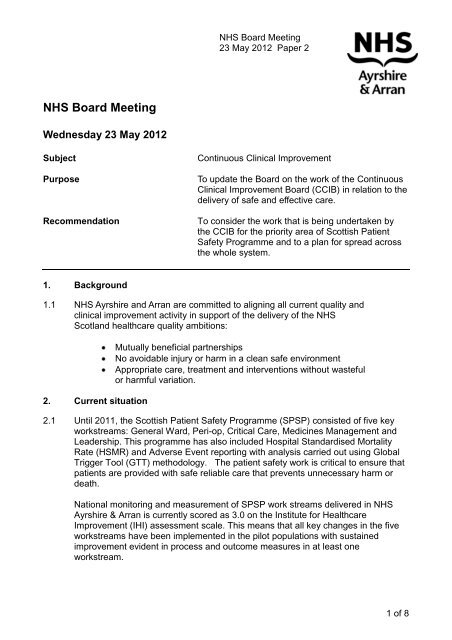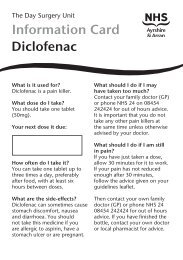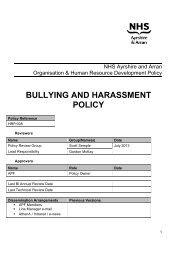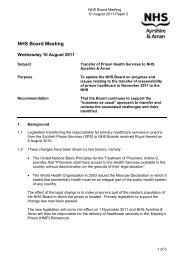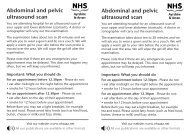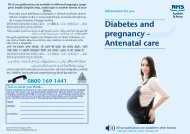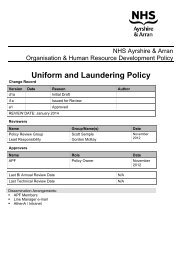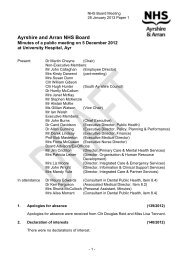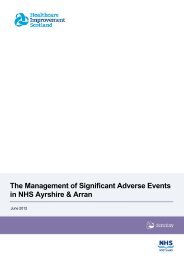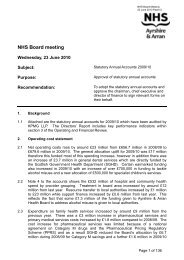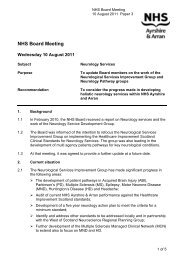Paper 02 - NHS Ayrshire and Arran.
Paper 02 - NHS Ayrshire and Arran.
Paper 02 - NHS Ayrshire and Arran.
Create successful ePaper yourself
Turn your PDF publications into a flip-book with our unique Google optimized e-Paper software.
<strong>NHS</strong> Board Meeting23 May 2012 <strong>Paper</strong> 2<strong>NHS</strong> Board MeetingWednesday 23 May 2012SubjectPurposeRecommendationContinuous Clinical ImprovementTo update the Board on the work of the ContinuousClinical Improvement Board (CCIB) in relation to thedelivery of safe <strong>and</strong> effective care.To consider the work that is being undertaken bythe CCIB for the priority area of Scottish PatientSafety Programme <strong>and</strong> to a plan for spread acrossthe whole system.1. Background1.1 <strong>NHS</strong> <strong>Ayrshire</strong> <strong>and</strong> <strong>Arran</strong> are committed to aligning all current quality <strong>and</strong>clinical improvement activity in support of the delivery of the <strong>NHS</strong>Scotl<strong>and</strong> healthcare quality ambitions:2. Current situationMutually beneficial partnershipsNo avoidable injury or harm in a clean safe environmentAppropriate care, treatment <strong>and</strong> interventions without wastefulor harmful variation.2.1 Until 2011, the Scottish Patient Safety Programme (SPSP) consisted of five keyworkstreams: General Ward, Peri-op, Critical Care, Medicines Management <strong>and</strong>Leadership. This programme has also included Hospital St<strong>and</strong>ardised MortalityRate (HSMR) <strong>and</strong> Adverse Event reporting with analysis carried out using GlobalTrigger Tool (GTT) methodology. The patient safety work is critical to ensure thatpatients are provided with safe reliable care that prevents unnecessary harm ordeath.National monitoring <strong>and</strong> measurement of SPSP work streams delivered in <strong>NHS</strong><strong>Ayrshire</strong> & <strong>Arran</strong> is currently scored as 3.0 on the Institute for HealthcareImprovement (IHI) assessment scale. This means that all key changes in the fiveworkstreams have been implemented in the pilot populations with sustainedimprovement evident in process <strong>and</strong> outcome measures in at least oneworkstream.1 of 8
Sustained improvement relates to run chart rules <strong>and</strong> a requirement to evidenceimprovement with nine data points travelling in the desired direction.In order to achieve an assessment of 3.5, the local programme is required toevidence sustained improvement in process <strong>and</strong> outcome measures for pilotpopulations across all five workstreams with spread of all key changes underwaybeyond the pilot populations.Achieving this level of reliability for all measures in all workstream pilot sites hasbeen challenging <strong>and</strong> has required the clinical teams to test a number of differentapproaches using improvement methodology to continuously learn <strong>and</strong> driveimprovements in clinical processes. Spreading the improvement work to otherpopulations beyond the pilot sites is evident with a number of clinical teamsadopting the changes, testing approaches to achieve reliable process <strong>and</strong>measuring performance as part of the improvement journey. Spread has beenparticularly successful in the general ward workstream using Back to Basics. Usingthe Back to Basics approach, Clinical Improvement Practitioners work in the wardswith clinical staff to directly support the implementation of clinical changes thatresult in improvements in process <strong>and</strong> outcome.It has been agreed that a comprehensive plan for spread across the whole systemwill be developed <strong>and</strong> reported to the Clinical Governance Committee.2.2 The SPSP has been developing <strong>and</strong> growing significantly over the past 12 monthswith the introduction of the Paediatric Programme in 2011, commencement of theannual Board on Board events <strong>and</strong> the launch of the Sepsis/Venous ThromboEmbolism (VTE) collaborative in January of this year. There are three furtherprogrammes under development nationally <strong>and</strong> these are expected to beintroduced over the next twelve months; Mental Health, Maternity <strong>and</strong> PrimaryCare.2.3 HSMRThis breadth of patient safety improvement programmes, <strong>and</strong> the increasingnumber of clinical teams involved, needs to be adequately supported by theClinical Improvement Unit (CIU) to ensure that the clinical teams involved in theimprovement work are supported to deliver the desired outcomes.<strong>NHS</strong> <strong>Ayrshire</strong> & <strong>Arran</strong> is making good progress with SPSP measures in the pilotsites, all bundles <strong>and</strong> processes are being tested, implemented <strong>and</strong> spread asappropriate. There are noted variable processes of compliance in some of the pilotsites that have required a better underst<strong>and</strong>ing of the data by staff in order toachieve reliability.The HSMR data released in February 2012 for the period April – June 2011,demonstrates a 24% reduction for Crosshouse Hospital <strong>and</strong> an 11% reduction forAyr Hospital. This data does come with the caveat that it may need to be revisedas the submission was incomplete, this is as a consequence of the implementationof the Patient Management System (PMS). The next data release is expected inMay 2012 <strong>and</strong> the Board has submitted all information required to generate HSMRdata, any necessary revisions in the April – June 2011 data will also be producedat this time.2 of 8
Problems are still present in relation to the production of 1000 occupied bed dayswhich is required to produce the unadjusted mortality rate. The Assistant Director,Information Services is exploring this issue with the provider of the new system toidentify a suitable solution to the problem.2.4 Adverse Events – GTTGTT work is progressing well, <strong>and</strong> more detailed analysis of the adverse eventsidentified is being undertaken to provide a better underst<strong>and</strong>ing of clinicalprocesses <strong>and</strong> procedures that have resulted in patient harm. Further work isbeing undertaken to analyse the GTT data to explore how it can be usefullyinterrogated to provide information at a Directorate level. Although the samplesizes at Directorate level are small, this type of information is useful to identifythemes <strong>and</strong> issues to drive further exploration, learning <strong>and</strong> change2.5 Perioperative Work StreamThe team have been focussing their efforts to increase consistent compliance withmeasures for prophylactic antibiotic therapy, normothermia, glucose control <strong>and</strong>perioperative briefings. The following graphs demonstrate data showing theprogress of performance related to key measures in the pilot theatre followingimprovement activity by the team.Progress in the right direction noted in the pilot theatre for process measure ofprophylactic antibiotic administration. This has been supported by increasedcompliance with the antibiotic prescribing policy. This improving picture isbeginning to be reflected across other theatres also.3 of 8
Sustainable improvement (shift of nine data points) noted in pilot theatre forperioperative glucose control. This has not yet impacted on progress in othertheatres <strong>and</strong> learning from the improvement achieved by the pilot theatre willsupport other theatre teams.Although this measure appears to be experiencing less variation, there areongoing issues which prevent consistent achievement of >95% compliance innormothermia management postoperatively. The team are testing differentapproaches to achieve a reliable process for maintenance of patient temperature inthe post operative period.4 of 8
Reliable process is now evident in the pilot theatre. Reduced variation is becomingevident in compliance with perioperative briefings across a number of theatres, <strong>and</strong>whilst there is a trend of improvement in the spread theatres, sustainedimprovement has not been achieved.2.6 Heart Failure BundleProgress being made in relation to the Heart Failure bundle work is being led byone of the current cohort of SPSP Fellows. It is anticipated that testing of newapproaches will lead to improved processes that can be evidenced throughmeasurement of compliance <strong>and</strong> included for national reporting in the near future.2.7 SPSP Paediatric ProgrammeThe SPSP Paediatric Programme has been embraced by the paediatric wardteams at Crosshouse Hospital with change packages <strong>and</strong> measurement plansbeing taken forward with improvement methodology. The multidisciplinary team isengaged in a variety of improvement activities to drive forward the programme <strong>and</strong>is beginning to monitor <strong>and</strong> report progress on performance on the ClinicalImprovement Portal.2.8 Sepsis/VTE CollaborativeSPSP launched the Sepsis/VTE Collaborative in January 2012 as a further steptowards driving forward the programme aims of 15% reduction in mortality <strong>and</strong>30% reduction in harm. In <strong>NHS</strong> <strong>Ayrshire</strong> & <strong>Arran</strong> this has led to the forming of twomultidisciplinary teams to support the progress of improvement work being takenforward by current SPSP Fellows. Testing of improved practices <strong>and</strong> processes tosupport the change packages is underway <strong>and</strong> Plan, Do, Study, Act (PDSA) cyclesare being adopted <strong>and</strong> monitored to guide the learning <strong>and</strong> progress of the work.This work will contribute to national data reporting as the programme progresses.5 of 8
2.9 Future Work ProgrammeAs described above the workstreams for the SPSP are continuing to grow. Theadditional programmes anticipated in the following twelve months will each bringchange packages <strong>and</strong> measurement plans for testing <strong>and</strong> implementation. Thesewill also become part of the measurement <strong>and</strong> monitoring programme nationally asthe programmes progress.Anticipation of the growing patient safety improvement programmes has led to therevision <strong>and</strong> restructuring of the approach taken by the Clinical Improvement Unit(CIU) to manage the support, coordination <strong>and</strong> reporting of progress from acrossthe Health Board. Annex 1 outlines the restructuring of SPSP programmemanagement <strong>and</strong> coordination in <strong>NHS</strong> <strong>Ayrshire</strong> <strong>and</strong> <strong>Arran</strong>.3. Proposal3.1 The Clinical Governance Committee have considered the progress across theSPSP work streams <strong>and</strong> have asked that a plan <strong>and</strong> timeline for spread of the 5original workstreams be developed <strong>and</strong> presented for revision <strong>and</strong> or approval atthe Clinical Governance Committee on Wednesday 20 th June 2012The Clinical Governance Committee also supported the proposed approach to therestructuring of SPSP programme management <strong>and</strong> coordination in <strong>NHS</strong> <strong>Ayrshire</strong><strong>and</strong> <strong>Arran</strong>.4. Engagement <strong>and</strong> consultation on development of the proposal4.1 The content of this report is a reflection of discussions between staff inthe Healthcare Quality, Governance <strong>and</strong> St<strong>and</strong>ards Unit, ClinicalImprovement Unit <strong>and</strong> the Continuous Clinical Improvement Board <strong>and</strong>Clinical Governance Committee.5. Resource implications <strong>and</strong> identified source of funding5.1 All of the proposals within this paper will be delivered within existingresources, taking account of the need to deliver cash releasing efficiencysavings. The reduction of rates of harm will have a positive impact onlength of stay <strong>and</strong> cost of care episodes.6. Risk assessment <strong>and</strong> mitigation6.1 Systems, processes <strong>and</strong> structures are being implemented to ensure that allknown risks to the delivery of the quality ambitions are being mitigated.7. Impact assessment <strong>and</strong> consequential changes proposed to mitigateadverse impacts identified7.1 This is an internal document that does not require impact assessment.6 of 8
8. Conclusion8.1 The patient safety work is critical to ensure that patients are provided with safereliable care that prevents unnecessary harm or death. The increased informationfrom Global Trigger Tool will now be able to be used at a specialty level to facilitatelearning <strong>and</strong> improvement from adverse events.Board members are asked to note the revised structure of the ClinicalImprovement Unit support <strong>and</strong> co-ordination across all existing <strong>and</strong> newsafety workstreams.Robert Masterton, Executive Medical DirectorFiona McQueen, Executive Nurse Director[Craig White, Diane Murray]25 April 20127 of 8
Scottish Patient Safety Programme <strong>NHS</strong> <strong>Ayrshire</strong> & <strong>Arran</strong>Structure for clinician <strong>and</strong> clinical improvement leadership <strong>and</strong> support across allprogrammes/workstreamsAnnex 1Diane MurrayAssistant DirectorClinical Improvement&Management ofScottish Patient Safety ProgrammeSusan HannahClinical Improvement&Patient Safety LeadSharon MooreCI CO-ORDDonna GreenSPSP CO-ORDGeneralWardGOCritical CareSFPeri-opYCMedicinesManagementPM/CRLeadershipGTTClinical PortalJMcCMentalHealthSMcEMaternityYC/LDSepsis/ VTEED/PHCIUPaediatricsSHHSMRCR/JMcCThe SPSP has developed considerably over recent months with the launch of the Paediatric programme <strong>and</strong> Sepsis <strong>and</strong>VTE Collaborative. Further programmes for Mental Health, Maternity <strong>and</strong> Primary Care are being developed nationally.In order to provide an appropriate level of support to each of the workstreams <strong>and</strong> programmes it is necessary tostructure the allocation of responsibility across the CIU <strong>and</strong> SPSP Fellows enabling a qualitative approach to support thefurther progress of the workstreams <strong>and</strong> provide timely reporting of progress. Clinicians continue to perform the leadingrole in the existing workstreams with CIU supporting the teams to progress improvement activity that will achieve spreadacross services.8 of 8


